Spanish Colonial Fortifications of the Philippines
The Spanish Colonial Fortifications of the Philippines are strongholds constructed by Filipinos and Spanish under the rule of the Spaniards in the Philippines for protection against local and foreign aggressors during the Spanish Colonial Period. The fortifications were also used during the American and Japanese occupation eras. Many of the fortifications have been bady damaged, either due to old age or conflicts in the past. Currently, there has been initiatives to restore all Spanish fortifications throughout the Philippines. The initiative began when the Baluarte Luna of La Union and the Intramuros of Manila were restored in the 2010s. In 2013, a typhoon and earthquake hit Central Visayas and damaged numerous Spanish fortifications. This led to the largest restoration activity for fortifications in Philippine history.
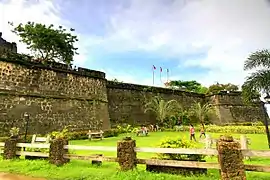
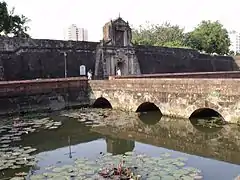
.jpg.webp)
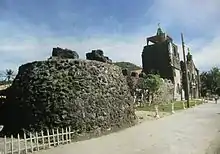
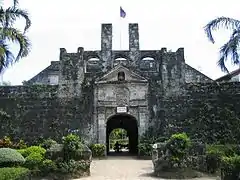
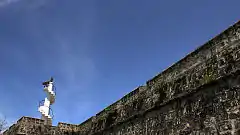
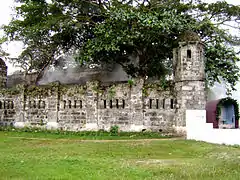
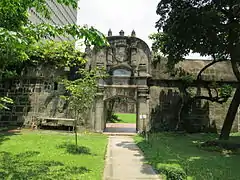
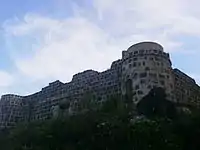
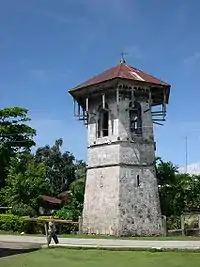
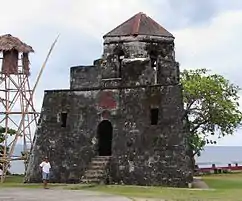
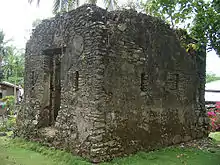
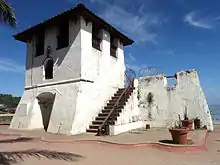
_of_Luna.JPG.webp)
World Heritage Tentative List
On May 16, 2006, a collection of five well-preserved examples of Spanish Colonial architecture was added to the UNESCO World Heritage Tentative List in the Cultural category.[1]
The collection titled "Spanish Colonial Fortifications of the Philippines" include the following buildings located throughout the country:
- Fuerza de Capul, Northern Samar
- Dauis Watchtower, Dauis, Bohol
- Punta Cruz Watchtower, Maribojoc, Bohol
- Fuerza de San Andres, Romblon, Romblon
- Fuerza de Sta. Isabel, Taytay, Palawan
In 2015, by recommendation of UNESCO, the fortifications were removed from the tentative list of the Philippines as they 'will have a hard time meeting the standards of the organization'. The old town of Capul (Northern Samar), old town of Romblon (Romblon province), and old town of Taytay (Palawan) were recommended as possible heritage sites in the future once the Philippines submits them in the tentative list, along with a complete dossier.
Future re-inclusion
Heritage groups have been advocating for the return of the fortifications in the tentative list, but with the inclusion of at least twenty-one more Spanish colonial fortifications throughout the country to maximize its potential to be included in the World Heritage List. Restoration activities on numerous fortifications throughout the country are currently ongoing in a bid to support the future nomination of the fortifications to UNESCO. However, some fortifications are within private lands, hindering cultural agencies of government from restoring those forts. The possible return of the fortifications in the tentative list is supported by both governments of the Philippines and Spain. Other properties being proposed to be included for the re-nomination are:
- Intramuros, Manila
- Cuartel de Santo Domingo, Santa Rosa, Laguna
- Fuerza de Cuyo, Cuyo, Palawan
- Fuerza de Cagayancillo, Cagayancillo, Palawan
- Real Fuerza de Nuestra Señora del Pilar de Zaragoza, Zamboanga City
- Fuerza de San Felipe, Cavite City
- Fuerza de San Pedro, Cebu
- Fuerte dela Concepcion y del Triunfo, Ozamiz, Misamis Occidental
- Fuerza de San Antonio Abad, Manila
- Fuerza de Pikit, Pikit, Cotabato
- Fuerza de Santiago, Romblon, Romblon
- Fuerza de Jolo, Jolo, Sulu
- Fuerza de Masbate, Masbate
- Fuerza de Bongabong, Bongabong, Oriental Mindoro
- Cotta de Dapitan, Dapitan, Zamboanga del Norte
- Fuerte de Alfonso XII, Tukuran, Zamboanga del Sur
- Fuerza de Bacolod, Bacolod, Lanao del Norte
- Guinsiliban Watchtower, Guinsiliban, Camiguin
- Laguindingan Watchtower, Laguindingan, Misamis Oriental
- Kutang San Diego, Gumaca, Quezon
- Baluarte Luna, Luna, La Union
See also
References
LUENGO, Pedro. La fortificación del archipiélago filipino en el siglo XVIII. La defensa integral ante lo local y lo global. Revista de Indias, [S.l.], v. 77, n. 271, p. 727-758, nov. 2017. ISSN 1988-3188. Disponible en: <http://revistadeindias.revistas.csic.es/index.php/revistadeindias/article/view/1058>. Fecha de acceso: 22 sep. 2018 doi:https://dx.doi.org/10.3989/revindias.2017.021.
External links
- Spanish Colonial Fortifications of the Philippines - UNESCO World Heritage Centre Retrieved 2009-03-03.